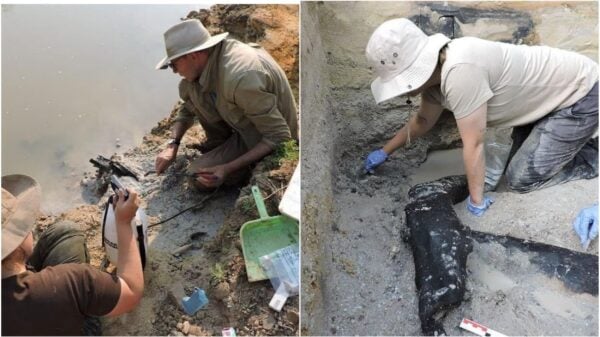For the past four years, Albert Hafner and his team of Swiss and Albanian archaeologists have been excavating beneath the surface of beautiful Lake Ohrid in Albania, and they have found something that may change the way we understand ancient European people forever.
Lake Ohrid is said to be more than one million years old and is considered one of the oldest lakes in the world. And while the waters are full of lush vegetation, making it extremely difficult to excavate, archaeological divers have made their way through the bottom of this ancient lake and discovered something truly incredible.
They found a village, built almost entirely on stilts, and through radiocarbon dating, they’ve determined that the site was built between 6000 and 5800 BC, making it around 8,000 years old.
Before this amazing finding, the oldest known lakeside village in Europe was found in the Italian Alps and was dated to about 5000 BC. Which means the new site predates the former from anywhere between several hundred and a thousand years.
They believe that the village once housed somewhere between 200 and 500 people, and that the stilts were built to protect the homes through flooding and rising waters. Albanian archaeologist, ADrian Anastasi explains, “Building their village on stilts was a complex task, very complicated, very difficult, and it’s important to understand why these people made this choice.”
They have also found various seeds, plants, and bones of both wild and domesticated animals, which has led researchers to believe that the residents of this ancient village used agricultural practices, including raising livestock, to feed themselves.
Of course, the age of this village is enough to make it wildly interesting to archaeologists and scientists in a wide variety of fields. But there is something else about this site that makes it even more fascinating: It is completely surrounded by wooden spikes.
In fact, divers have found roughly 100,000 spikes under the lake’s surface, which signifies that the residents would have had to cut down almost an entire forest to create their fortress. And while Hafner believes the spikes were certainly installed for protection, the professor and his team still have many questions regarding this interesting finding.
Who were the villagers so afraid of? Why was such an intense fortification needed? Hafer is calling this discovery “a real treasure trove for research.”
The finding is so significant that Swiss Ambassador Ruth Huber visited the excavations to acquire an in-depth understanding, and Albanian Prime Minister Edi Rama proudly posted on Facebook stating that the village has “undisputed historical and archaeological value.”
Because of the rich underwater vegetation, it’s reported that it will take another two decades to fully explore and study the ancient village found below Lake Ohrid. But researchers are dedicated to doing just that.
Hafner has made its importance abundantly clear when he said, “These are key prehistoric sites that are of interest not only to the region but to the whole of southwest Europe.”


















